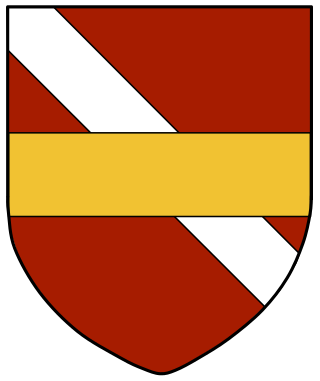
Wymondham Abbey is the Anglican parish church for the town of Wymondham in Norfolk, England.
Hugh Bigod, 1st Earl of Norfolk (1095–1177) was the second son of Roger Bigod, sheriff of Norfolk and royal advisor, and Adeliza, daughter of Robert de Todeni.

Roger Bigod was the son of Hugh Bigod, 1st Earl of Norfolk and his first wife, Juliana de Vere. Although his father died in 1176 or 1177, Roger did not succeed to the earldom of Norfolk until 1189 for his claim had been disputed by his stepmother for her sons by Earl Hugh in the reign of Henry II. King Richard I confirmed him in his earldom and other honours, and also sent him as an ambassador to France in the same year. Roger inherited his father's office as royal steward. He took part in the negotiations for the release of Richard from prison, and after the king's return to England became a justiciar.

William Longespée, 3rd Earl of Salisbury was an Anglo-Norman nobleman, primarily remembered for his command of the English forces at the Battle of Damme and for remaining loyal to his half-brother, King John. His nickname "Longespée" is generally taken as a reference to his great physical height and the oversize weapons that he used.

Thetford is a market town and civil parish in the Breckland District of Norfolk, England. It is on the A11 road between Norwich and London, just east of Thetford Forest. The civil parish, covering an area of 29.55 km2 (11.41 sq mi), in 2011 had a population of 24,340.

William FitzOsbern, 1st Earl of Hereford, Lord of Breteuil, was a relative and close counsellor of William the Conqueror and one of the great magnates of early Norman England. FitzOsbern was created Earl of Hereford in 1067, one of the first peerage titles in the English peerage. He is one of the very few proven companions of William the Conqueror known to have fought at the Battle of Hastings in 1066. His chief residence was Carisbrooke Castle on the Isle of Wight, one of many castles he built in England.
Aubrey de Vere — also known as "Alberic[us] de Ver" and "Albericus regis camerarius" — was the second of that name in England after the Norman Conquest, being the eldest surviving son of Aubrey de Vere and his wife Beatrice.

The House of Mowbray was an Anglo-Norman noble house, derived from Montbray in Normandy and founded by Roger de Mowbray, son of Nigel d'Aubigny.
Richard fitz Gilbert, 1st feudal baron of Clare in Suffolk, was a Norman lord who participated in the Norman conquest of England in 1066, and was styled "de Bienfaite", "de Clare", and of "Tonbridge" from his holdings.
William d'Aubigny, also known as William d'Albini, William de Albini and William de Albini II, was an English nobleman. He was son of William d'Aubigny and Maud Bigod, daughter of Roger Bigod of Norfolk.

Ralph de Gaël was the Earl of East Anglia and Lord of Gaël and Montfort. He was the leading figure in the Revolt of the Earls, the last serious revolt against William the Conqueror.

Thetford Priory is a Cluniac monastic house in Thetford, Norfolk, England. Founded in 1103 by Roger Bigod of Norfolk, Thetford was one of the most important monasteries of East Anglia.
Robert de Stafford was an Anglo-Norman nobleman, the first feudal baron of Stafford in Staffordshire in England, where he built as his seat Stafford Castle. His many landholdings are listed in the Domesday Book of 1086.
Events from the 1100s in England.

The House of Tosny was an important noble family in 10th and 11th century Normandy, though it did not include any comtes or vicomtes. Its founder was Raoul I of Tosny.
Ida de Tosny, Countess of Norfolk, was a Norman royal mistress. Named after her grandmother Ida de Hainaut, she was the daughter of Ralph IV de Tosny and his wife Margaret, a daughter of Robert de Beaumont, 2nd Earl of Leicester.
The Battle of Fornham was a battle that was fought during the Revolt of 1173–1174.
William d'Aubigny, sometimes William de Albini, was an Anglo-French baron and administrator who served successive kings of England and acquired large estates in Norfolk. From his title of Butler to King Henry I of England, he was called William d'Aubigny Pincerna to distinguish him from other men of the same name.
William Bigod, the heir to the Norfolk earldom, drowned in the disaster of the White Ship as she set sail from Normandy in 1120. The ship also carried the son of the King of England Henry I, William Adelin, who also died. The succession of Henry I to the throne of England was secured not only by the mysterious death of his brother King William II Rufus but by the defeat of his eldest brother Robert Curthose, Duke of Normandy. The death of Henry's heir to the throne set in motion a succession crisis that lasted many years.

The Domesday Book of 1086 AD lists King William the Conqueror's tenants-in-chief in Snotinghscire (Nottinghamshire), following the Norman Conquest of England: